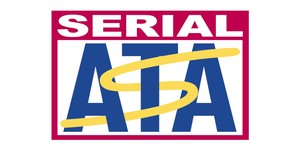
SATA-IO, the industry group behind the Serial ATA standard, has formally released the SATA 3.2 specification with the promise of boosting transfer rates as high as 16Gb/s in future devices.
The latest revision of the long-running SATA specification, SATA 3.2 brings a number of improvements for storage devices - but by far the most interesting is SATA Express. A variant of SATA first announced back in January this year, SATA Express uses up to two PCI Express 3.0 lanes to offer a peak transfer rate of 16Gb/s, or 2GB/s, compared to SATA 3's 6Gb/s.
To visualise the performance difference, it's easiest to fall back on the old Blu-ray comparison: a SATA 3 storage device capable of saturating the 6Gb/s bus speed would transfer a 50GB Blu-ray image in around 67 seconds; a storage device running over SATA Express, meanwhile, could do the same in just 25 seconds.
Naturally, you need your storage device to keep up with the performance of the bus: most current SATA 3 devices struggle to reach anywhere near the 6Gb/s theoretical limit, with most solid-state drives (SSDs) peaking somewhere around 4.8Gb/s at best. The exception is in high-performance RAID arrays of multiple devices, which are becoming increasingly popular in the enterprise as first-line non-volatile storage for databases and other performance-critical files.
While SSDs that connect directly to a PCI Express bus already exist, the SATA 3.2 standard is about compatibility: a host compliant with the specification, SATA-IO explains, will be able to address storage over PCI Express or traditional SATA transparently. The group does, however, predict a future in which solid-state mass storage is exclusively connected via SATA Express over PCI Express, with traditional SATA ports being used purely for low-performance mechanical and optical drives.
SATA 3.2 isn't just about increased speed, however. The new specification also brings support for the Next Generation Form Factor (NGFF) defined by the PCI Special Interest Group (PCI-SIG). Now known as M.2, the ultra-compact cards will include the option of SATA connectivity for use as a storage form factor alongside Wi-Fi, WWAN, USB and PCI Express capabilities.
The specification also includes the micro-SSD standard for embedded storage devices, a slimmer variant of the Universal Storage Module (USM) form factor, a new ultra-low power device suspension level dubbed DevSleep, transactional energy reporting for better power management, a system for better controlling the data caching system on solid-state hybrid drives (SSHDs) and a feature for speeding up the process of rebuilding a RAID array.
'SATA technology continues to evolve to accommodate ever-changing storage industry requirements,' claimed Mladen Luksic, SATA-IO president, at the specification's announcement. 'The updates featured in the revision 3.2 specification, such as SATA Express and enhancements for emerging solid state hybrid drives, are driven by current market trends. These new features demonstrate SATA-IO’s ongoing commitment to providing low-cost, high-performance storage solutions.'
The latest revision of the long-running SATA specification, SATA 3.2 brings a number of improvements for storage devices - but by far the most interesting is SATA Express. A variant of SATA first announced back in January this year, SATA Express uses up to two PCI Express 3.0 lanes to offer a peak transfer rate of 16Gb/s, or 2GB/s, compared to SATA 3's 6Gb/s.
To visualise the performance difference, it's easiest to fall back on the old Blu-ray comparison: a SATA 3 storage device capable of saturating the 6Gb/s bus speed would transfer a 50GB Blu-ray image in around 67 seconds; a storage device running over SATA Express, meanwhile, could do the same in just 25 seconds.
Naturally, you need your storage device to keep up with the performance of the bus: most current SATA 3 devices struggle to reach anywhere near the 6Gb/s theoretical limit, with most solid-state drives (SSDs) peaking somewhere around 4.8Gb/s at best. The exception is in high-performance RAID arrays of multiple devices, which are becoming increasingly popular in the enterprise as first-line non-volatile storage for databases and other performance-critical files.
While SSDs that connect directly to a PCI Express bus already exist, the SATA 3.2 standard is about compatibility: a host compliant with the specification, SATA-IO explains, will be able to address storage over PCI Express or traditional SATA transparently. The group does, however, predict a future in which solid-state mass storage is exclusively connected via SATA Express over PCI Express, with traditional SATA ports being used purely for low-performance mechanical and optical drives.
SATA 3.2 isn't just about increased speed, however. The new specification also brings support for the Next Generation Form Factor (NGFF) defined by the PCI Special Interest Group (PCI-SIG). Now known as M.2, the ultra-compact cards will include the option of SATA connectivity for use as a storage form factor alongside Wi-Fi, WWAN, USB and PCI Express capabilities.
The specification also includes the micro-SSD standard for embedded storage devices, a slimmer variant of the Universal Storage Module (USM) form factor, a new ultra-low power device suspension level dubbed DevSleep, transactional energy reporting for better power management, a system for better controlling the data caching system on solid-state hybrid drives (SSHDs) and a feature for speeding up the process of rebuilding a RAID array.
'SATA technology continues to evolve to accommodate ever-changing storage industry requirements,' claimed Mladen Luksic, SATA-IO president, at the specification's announcement. 'The updates featured in the revision 3.2 specification, such as SATA Express and enhancements for emerging solid state hybrid drives, are driven by current market trends. These new features demonstrate SATA-IO’s ongoing commitment to providing low-cost, high-performance storage solutions.'

MSI MPG Velox 100R Chassis Review
October 14 2021 | 15:04








Want to comment? Please log in.